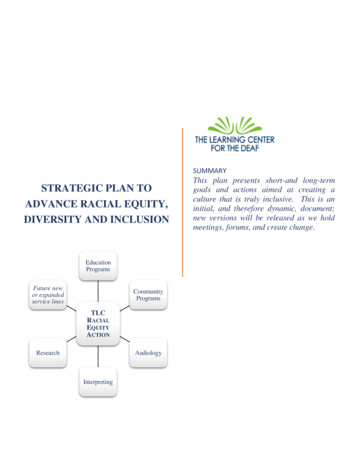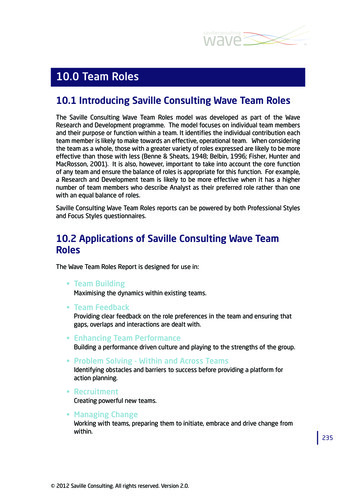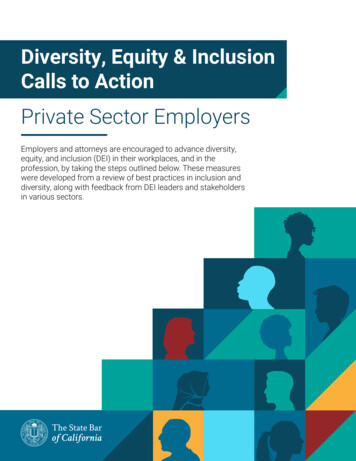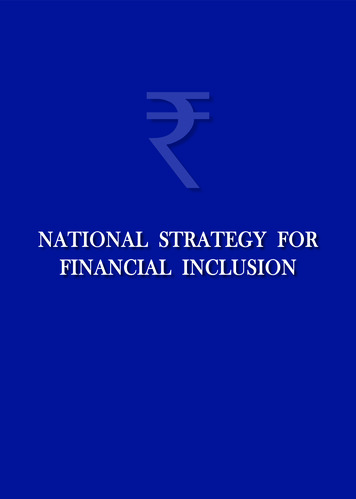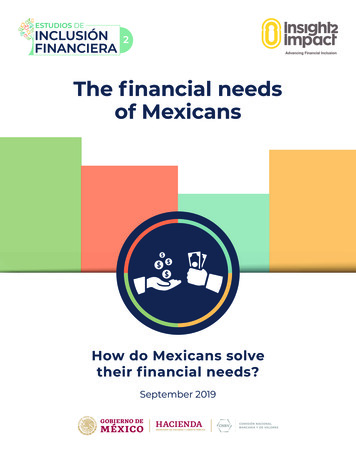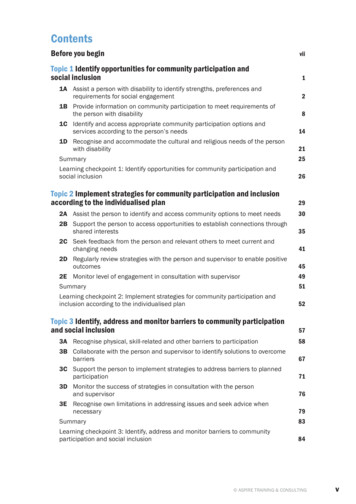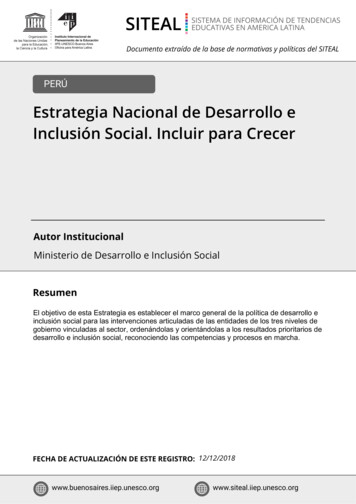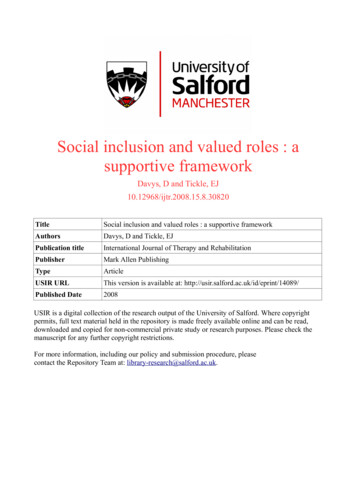
Transcription
Social inclusion and valued roles : asupportive frameworkDavys, D and Tickle, EJ10.12968/ijtr.2008.15.8.30820TitleSocial inclusion and valued roles : a supportive frameworkAuthorsDavys, D and Tickle, EJPublication titleInternational Journal of Therapy and RehabilitationPublisherMark Allen PublishingTypeArticleUSIR URLThis version is available at: d Date2008USIR is a digital collection of the research output of the University of Salford. Where copyrightpermits, full text material held in the repository is made freely available online and can be read,downloaded and copied for non-commercial private study or research purposes. Please check themanuscript for any further copyright restrictions.For more information, including our policy and submission procedure, pleasecontact the Repository Team at: library-research@salford.ac.uk.
Social inclusion and valued roles: a supportive frameworkAbstractThe aim of this paper is to examine the concepts of social exclusion, socialinclusion and their relevance to health, well-being and valued social roles. Thearticle presents a framework, based on Social Role Valorization (SRV), whichwas developed initially to support and sustain socially valued roles for those whoare, or are at risk of, being devalued within our society. The frameworkincorporates these principles and can be used by health professionals across arange of practice, as a legitimate starting point from which to support theacquisition of socially valued roles which are integral to inclusion.98 wordsIntroductionThere are a number of individuals who are marginalised within society due to avariety of reasons, one of which is disability, and as a result are prevented fromparticipating in everyday life. The World Health Organisation’s (WHO) (2001)International Classification of Functioning, Disability and Health has defineddisability as"the outcome or result of a complex relationship between an individual'shealth condition and personal factors, and of the external factors ives"(www.who.int/classifications/icf).This change in definitiondemonstrates a shift from the medical model ofdisability to the social model, where the inability to be integrated into society liesnot with the individual themselves, but on the barriers caused by structures,policies and practices prevalent in society (Ware et al, 2007).In 1995 the UK government, through the publication of the DisabilityDiscrimination Act, made it unlawful to discriminate against individuals who havea disability, and thereby promote social inclusion. To eliminate discrimination, the1
Disability Rights Commission was established in 2000, and provided amechanism to offer information to relevant individuals and agencies, to establishcodes of practice and ensure these were adhered to, and to act as arbitrator incases where disputes involving potential discrimination arose (Smith andKeenan, 2004).Social Role Valorization (Wolfensberger, 1980) is considered to be a means ofsupporting the development and maintenance of socially valued roles by the useof culturally valued means to ensure that people have the same living conditionsthat are at least equivalent to the average citizen.Health care professionals maybe considered as well placed to identify the potential for this to happen withintheir client group, and may be able to minimise or reduce the potential for thoseindividuals to maintain social inclusion. In tackling the root causes of exclusion,which has been associated with either maximizing ill health or as a direct result ofthis, it would be hoped that social inclusion could be engendered (Burnett andPeel, 2001), leading to improved health and wellbeing.Social exclusionA report published by Levitas et al (2007, p 9) defined social exclusion as:“a complex and multi-dimensional process. It involves the lack or denial ofresources, rights, goods and services, and the inability to participate in thenormal relationships and activities, available to the majority of people in asociety, whether in economic, social, cultural or political arenas. It affectsboth the quality of life of individuals and the equity and cohesion of society asa whole”.In essence, social exclusion is a process whereby individuals or groups arepartially or wholly excluded from full participation in the life of their community.In 1997, the Social Exclusion unit was commissioned in the UK with the remit oftackling the causes of social exclusion and promoting inclusion of the mostdisadvantaged within society. Through the early identification of potential2
problems that result in social exclusion, the government aims to demonstrate thatby providing support and preventative mechanisms, positive change is possible.The need to tackle social exclusion has also been recognised at European levelas recognised in the Joint Report of Social Protection and Social Inclusion 2008(http://ec.europa.eu/employment) which states that health inequalities negativelyaffect the most vulnerable groups in society and that poor health contributestowards social exclusion and loss of human and economic potential.TheEuropean Union has produced national actions plans such as the use ofuniversal design to make environments, products, communication systems andservices usable by all yet avoiding solutions that could lead to stigma andseparation (https://wcd.coe.int). Similarly, social enterprise brings like mindedbusiness together for the good of the whole community. In its social enterpriseaction plan, Scaling New Heights (DH 2006) the UK government recognises thevalue to society of reinvesting capital by businesses who are interested in thedevelopment of the community rather than being driven by profit. It establishesseveral ways of how this will be achieved, including providing advice and supportto businesses, overcoming barriers regarding finance and resource implicationsand encouraging social enterprises to work collaboratively with governmentdepartments.Social inclusionSocial inclusion could be seen as an ideal that modern society aspires to,however it has been considered as a difficult concept to define, which may bedue in part to the multifaceted nature of the reasons why individuals are excludedfrom society (Wilcock 2006). Social inclusion is linked to the concept of equalopportunity, the individual is part of a social community where they wereeducated, raised and employed which is felt to engender feelings of belonging,trust and unity (Westwood 2003). If this does not occur, the individual canexperience marginalisation, alienation and distrust. In contrast to socialexclusion, inclusion exists where people are enabled to take part in the activitiesand roles that are part of mainstream society such as having a job (Wistow and3
Schneider 2003), visiting the local leisure facilities and taking part in family life.Inclusion is concerned with being able to access and utilise mainstream servicesand to be included fully in the life of the local community (DH, 2001)The Quality Assurance Agency (QAA) is responsible for the delivery of AlliedHealth Programmes in Higher Education Institutes within the UK and hasrecognised the need for socially inclusive practice. The agency has developedbenchmark statements as ‘authoritative reference points’ (QAA 2001, p11) toensure the undergraduate curriculum enables future health care professionals tobe fit for practice, and registration with the Health Professional Council is astatutory prerequisite for practice (www.hpc.uk, 2005).The benchmarkstatements clearly state that those eligible to practice should “contribute to thepromotion of social inclusion” (wwwqaa.ac.uk, 2001).Capabilities for Inclusive Practice”In a similar vein, the(DH, 2007) make reference to the TenEssential Shared Capabilities (Table 1) which states that issues of discrimination,exclusion and the maintenance of valued social roles for services users shouldbe core components of the curriculum for all professional and non professionalstaff including the allied health professions.Table 1The Ten Essential Shared Capacities – A framework for the whole of the MentalHealth Workforce1Working in partnership with service users, families, carers and thewider community2Respecting and valuing diversity including age, race, disability, cultureand sexuality3Ethical practice that respects rights and aspirations, providingservices within professional, legal and local boundaries4Challenge inequality that includes stigma, discrimination andexclusion to create, develop and maintain valued social roles in localcommunities5Promote recovery to support people to tackle mental health issuesand work towards a valued lifestyle6Identify peoples strengths and needs alongside their preferred lifestyleand aspirations7Provide care that is centred on the service user4
8Make a difference, support access to and update of the best qualityand evidence based carePromote safety and positive risk taking via informed choicePersonal development planning that incorporates up to date life longlearning and persona and professional development910The importance of social roles and Social Role Valorization TheoryThe concept of valued social roles is considered to be intrinsically linked to theissues of social inclusion and exclusion (DH, 2007). It is through roles that peoplehave a place and are seen to have a place in the world. Roles define howpeople see themselves and how others see them, as well as shaping identity.The roles an individual may hold are likely to affect all aspects of life includingrelationships, what people do, where they go, routines, habits, services andresources available to them. Role also has a significant impact upon finance,which in turn has an influence upon the individual’s physical environment, dietand health and well-being (Race, 1999).Wolfensberger (1980) developed the concept of Social Role Valorization (SRV)to support the development and maintenance of valued roles for those people insociety who are at risk of devaluation. This concept was developed initially forpeople who have a learning disability but is equally of value for any person whomay be at risk of social devaluation including those who have mental healthneeds, older people and people who have a physical disability.Race (2003) states that those people who are commonly at risk of devaluationand therefore social exclusion within western society include: Those with some form of impairment of body, mind or senses Those whose behaviour is considered disordered People who are visibly different e.g. very tall, very short People who are or represent anti-establishment Those who are living below the poverty line5
Those with low levels of skill Those not assimilated into the dominant culture for reasons such asreligion, race, age, ethnicity, language, value system, immigrants andmigrants.It is important to note that some people fall into several of these categories andare therefore at risk of discrimination and exclusion on a variety of levels.According to the Government white paper “Valuing people” (DH, 2001) there arestill many people who live a life apart from mainstream society and have reducedlife opportunities. People at risk of exclusion need to have the same opportunitiesas other citizens. The drivers for this include increased awareness of moralissues and resultant public intolerance of the growing profile of inequalities facedby people who have a disability in western societies. This is being addressed byemergence of policy and legislation that supports inclusion, the civil rightsmovement and sociological theories that demonstrate how people who may be atrisk of devaluation have the capabilities to live in and make a positive contributionto their community (Race 1999). In addition to this, social exclusion is linked to apoor quality of life and ill-health, issues that are significant on the current UKgovernment agenda (HM Government 2006).According to the theory of social role valorisation, society will provide benefits tothose who hold valued social roles and in reference to Race (1999) the morevalued roles a person holds, the more others will tolerate or reinterpret negativeroles and characteristics.Significantly valued roles may therefore act as adefence against being devalued.A Framework against which to review servicesSocial role valorisation was underpinned by core service principles that wereadapted for the UK by O Brien and Tyne (1981) in the form of 5 serviceaccomplishments so that service providers have a strategy to operationalise thisconcept. The framework described within this paper is based on their service6
accomplishments, and incorporates concepts from those more recently proposedby the National Development Team (www.ndt.org.uk), who have developed the“Inclusion Traffic Light System”, the Social Inclusion Planner. Ideas suggested inRealising Recovery: A National Framework for Learning and Training inRecovery Focused Practice (2007) have also been included.The framework suggested within this paper (Table 2) can be used as a startingpoint from which to review existing services and from which action plans forimplementing change can be completed. This may help to promote and supportsocial inclusion and the acquisition of valued social roles within mainstreamcommunities for service users from a diverse variety of settings. Within thefollowing framework, several questions are posed which can be applied to eithera service or individual practitioner. Where there are obvious barriers within anarea of the framework, an action plan can be developed and priority list drawn upin negotiation with the service user, and their family/carers and service providers(Bates et al., 2006).Table 2A framework to support inclusionService ContextCurrent Service / Practice andAction PlanCommunity PresenceDo service users live in the samecommunity as ordinary citizens, loyment, use local shops and localrecreational facilities?ChoiceAre service users supported in makinginformed choices that are meaningful tothem and is choice presented on arange of issues from those that are7
small such as what to eat or wear, tolarger decisions such as career optionsand who they live with?CompetenceAre service users supported to functionwell with every day tasks that enablethem to be seen as individuals who areable and respected? Do people holdvalued social roles such as those oftenant,homeowner,friendorcolleague? How are people describedand perceived? Are people supportedto develop the skills and attributes thatreduce dependence on others, such asdeveloping skills in shopping, cookingor a work role?Are peopleencouraged to develop characteristicsthat are valued by others such as beingable to support others or demonstratingreliability, punctuality or accuracy?RespectAre people encouraged to develop andmaintain a positive reputation withintheir local community by considerationof the choice of activities, location,dress and use of language that assistspeople being perceived as valuedcitizens?Community ParticipationIs there evidence of service usersbeing supported to participate in thelocal community by developing andmaintaining natural relationships suchas those with their families, neighboursand other citizens and is there supportto assist people in increasing theirnetwork of relationships? Where dopeople spend their time, and who dothey spend time with, e.g. is it with paidstaff or other people with a disabilitywho may be at risk of socialdevaluation or ordinary citizens?8
Theoretical and practical challengesThere are a number of factors that need to be considered as services andindividual practitioners strive to implement strategies and practice that supportssocial inclusion and the acquisition of valued roles, the first being the concept ofSRV itself. Social role valorisation grew out of the earlier concept ofnormalisation and was renamed as people misinterpreted the concept asmeaning that people/ service users should fit in with society and appear “normal”,that they should present themselves, or behave in a way as other people would.The concept of social role valorization was developed and defined as the use ofculturally typical or valued means to support people at risk of devaluation to havethe same living conditions and be supported in their experiences, behaviour,status and reputation so that it is at least the same as the average citizen(Wolfensberger, 1980).One critique of SRV is that the guidelines and principles make assumptionsbased on sociology and psychology. SRV predicts what is likely to happen topeople in given circumstances and can offer practical suggestions (Race, 2003).However, that which is ultimately devalued or valued within a particular culture orcultural sub-set, and decisions regarding how far positive roles are defined andagreed upon, are not based on scientific fact but are culturally and sociallydetermined and are therefore subject to change. Ultimately the question of whoshould change or accommodate diversity, be this society or individuals who maybe at risk of devaluation, is related to the concept of values (Wolfensberger,1995)Resources are a common yet very real barrier to social inclusion and thedevelopment of valued social roles.One of the most common resourcedifficulties is that of available finances, and where there is not enough money toprovide adequate staffing levels or training.This directly impacts on serviceusers who will either be unable to attend events and activities that would supportsocial inclusion, or they will not have the appropriate type of support to enhance9
inclusion.Additionally, the opportunity to engage in the local community isdependent upon the level and extent of community services that are available tothe general public within a given locality (DH, 2007). It is also important to notethat social inclusion may be more difficult to achieve where people have profoundand complex requirements such as those with multiple physical andpsychological needs (Atherton, 2003).A further consideration when using such a framework is that staff, service usersand their carers need to understand the purpose and value of social inclusionHaving understood this, a Person-Centred Planning approach (DH, 2001) is thenrecommended to prioritise areas for development so that the wishes, needs andcapabilities of the service user, as well as the demands it will place upon serviceproviders, carers and families are adequately considered (DH, 2007). Anadditional and perhaps unexpected barrier to social inclusion and the acquisitionof valued social roles may come from health and social care providersthemselves. An example of this was demonstrated by Rosowsky (2005) whofound that service providers may hold negative views towards older people andthose with mental health problems and learning disability, which could possiblylead to the perpetuation of social devaluation and exclusion.Supporting social inclusionAccording to Valuing People (2001), the way forward requires a number ofinitiatives at different levels. The framework outlined within this article can beused as a starting point by service providers/individual practitioners to considerhow to promote social inclusion on a practical level. There are however furthercontextual factors that have wide reaching implications. In the UK, variation andinequality of services across the different regions needs to be redressed and theestablishment of effective partnerships and inter-agency co-operation across allsectors including health, social, private and voluntary is required. The need fortraining is also of consequence so that the workforce is qualified and has the10
skills to meet the needs of service users at both a professional and care stafflevel. In addition to this, effective joint working that includes greater partnershipworking with service users themselves and their carers/families utilising a client –centred approach should help to promote service user autonomy and choice.The need for work to be undertaken at different levels is reiterated by theNational Development Team (http://www.ndt.org.uk 2007), the LondonDevelopment Centre for Mental Health (2005), and is summarised by Race(1999) as follows: The individual level where strengths, abilities and resources are promotedand maintained The environmental level which considers the involvement of other peoplein the individuals life, the impact of the of the physical environment, andthe need for assistance, adaptations and modification A societal or systems approach that addresses the education andawareness of both the public and service providers in relation to socialvalues and the need for appropriate legislation, policies and health/socialservice support systems.ConclusionSocial inclusion is currently high on the agenda at both national and internationallevels. This is evidenced at a number of levels that include the growth of the civilrights movement, changes in public opinion towards discrimination againstpeople who have a disability and the awareness of links between health, wellbeing and social inclusion. Within government policies and legislation, therehave been changes within service planning and delivery with a shift towards amore social rather than medical model of care (Ware et al 2007) and theimplementation of sociological theories that has demonstrated the ability of thoseat risk of social exclusion to make a positive contribution to their community.In order to enhance social inclusion for the many groups of people within societywho are at risk of devaluation and therefore exclusion, support must be provided11
for the acquisition and maintenance of valued social roles as expressed withinSocial Role Valorisation theories.Valued social roles are critical within thisprocess since roles define how people see themselves, how others see them andcan affect all areas of life including where people live, their habits, routines,lifestyle and health (Race 1999).Inclusion is not simply about sharing places within a local community, but isabout fully participating in the social function of the community. Social inclusionhowever is difficult to achieve. It can be relatively easy to support physicalintegration as in the provision of appropriate housing and furnishings, but toachieve social integration and inclusion is much harder.The existence of aclimate of real inclusion and acceptance within our society is arguable andsupporting people in the acquisition of socially valued roles and lifestyles thatsupport inclusion still has a long way to go, especially within the developmentand maintenance of valued relationships (Atherton, 2003). For the health careprofessions therefore, this is a clear challenge to our practice and highlights theimportance of socially valued roles and their significance in supporting socialinclusion.Key Points:1) People may be at risk of devaluation and social exclusion because theypresent in some way as different to most other citizens, because they have lowlevels of skill or finances or because they are not assimilated into the dominantculture.2) Social inclusion is important to an individual’s health, quality of life and senseof well-being and is considered to be an important issue at national andinternational level12
3) People at risk of social exclusion need to be supported in the acquisition andmaintenance of valued social roles.4) The practical implementation of Social Role Valorisation Theories are likely tosupport social inclusion5) Supporting the development and maintenance of valued roles is an intrinsicrole for all health care professionalsReferencesAtherton, H. (2003) A History of Learning Disabilities in Gates,B (Ed) LearningDisabilities Towards Inclusion, 4th Edition. London: Churchill Livingstone.Bates, P., Gee, H., Klingel, U. and Lippmann, W. (2006) Moving to Inclusion.Mental Health Today, 16(8) pp16-18.Burnett A and Peel M (2001) Health needs of asylum seekers and refugeesBritish Medical Journal, 322 (7285) pp 544-547.Great Britain, Department of Health (2001) Valuing People: A New Strategy forLearning Disability for the 21st Century. London: HMSO.Great Britain, Department of Health (2004) The Ten Essential SharedCapabilities - A Framework for the whole of the Mental Health Workforce.London: HMSO.Great Britain, The Cabinet Office (2006) Reaching Out: An Action Plan on SocialExclusion Report. London: The Cabinet Office.13
Great Britain, Department of Health (2007) Capabilities for Inclusive Practice.London: HMSO.Great Britain, Department of Health (2007) Scaling New Heights. London:HMSO.Great Britain, Department of Health (2007) Social Inclusion Planner ansRealising Recovery: A National Framework for Learning and Training inRecovery Focused Practice .London: HMSO.Levitas, R., Pantazis, C., Fahmy, E., Gordon, D., Lloyd, E. and Patsios, D. (2007)The Multi-Dimensional Analysis of Social Exclusion. Department of Sociologyand School for Social Policy, Townsend Centre for the International Study ofPoverty and Bristol Institute for Public Affairs, University of BristolLondon Development Centre for Mental Health (2005) Redesigning mental healthday services – a modernisation toolkit for London. London: The LondonDevelopment Centre for Mental Health (CSIP).O’Brien and Tyne (1981) The principle of normalisation: a foundation for effectiveservices. London: CMH.Quality Assurance Agency for Higher Education (2001) The framework for highereducation qualifications in England, Wales and Northern Ireland. Gloucester:QAA.Race, D. (1999) Social Role Valorisation and the English Experience. London:Whiting and Birch Ltd.Race, D. (2003) Leadership and change in human services selected readingsfrom Wolf Wolfensberger (2003) London: RoutledgeRosowsky, E. (2005) Agiesm and Professional Training in Ageing: Who Will beThere to Help? Generations. Vol. 29 (3), pp55-58.Smith. K. and Keenan, D.J. (2004) Smith and Keenan's English Law London:Pearson EducationWare, N.C., Hopper, K., Tugenberg, T., Dickey, B. and Fisher, D. (2007)Connectedness and Citizenship. Psychiatirc Services, ps,psychiatryonline.org,58 (4), pp 469- 474.Westwood,J. (2003) The impact of adult education for mental health serviceusers. British Journal of Occupational Therapy. 66(11), pp505-10.Wilcock,A. (2006) An occupational perspective of health; Thofofare, NJ: Slack14
Wistow, R. and Scneider, J. (2003) Users' views on supported employment andsocial inclusion: a qualitative study of 30 people in work. British Journal ofLearning Disabilities 31(4) pp 166-74.Wolfensberger, W. (1980)The definition of normalization: update, problems,disagreements and misunderstandings. In Fylnn,R.J. and Nitsch,K.E. (eds)Normalization, Social Integration and Community Services, pp71-115. Balitmore:University Park Press.Wolfensberger, W. (1995) Social Role Valorization is too conservative. No it istoo radical. Disability and Society,10(3), pp245-7.Other sourceshttp://ec.europa.eu/employment social/spsi/docs/social inclusion/approb en.pdf(accessed 31 12 07)http://www.hpc-uk.org/ (accessed 21 02 08)http://www.ndt.org.uk/projectsN/SIPfeat.htm (accessed 21 02 chmark/health/ot (accessed 2102 08)https://wcd.coe.int/ViewDoc.jsp?id 1226267& (accessed on / (accessed 21 06 08)http://www.ndt.org.uk (accessed 21 06 08)http://ec.europa.eu/employment social/spsi/docs/social inclusion/2008/joint report en.pdf (accessed 27.06.08)15
both the quality of life of individuals and the equity and cohesion of society as a whole". In essence, social exclusion is a process whereby individuals or groups are partially or wholly excluded from full participation in the life of their community. In 1997, the Social Exclusion unit was commissioned in the UK with the remit of

